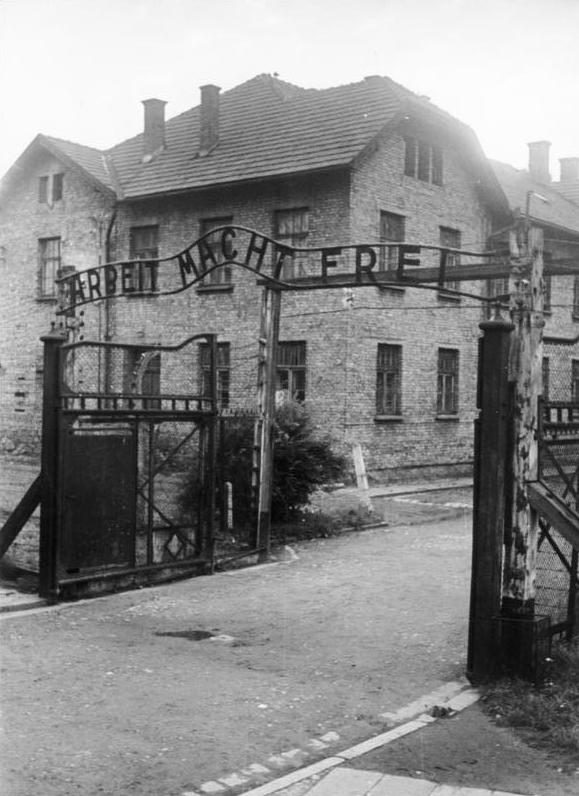|
Nasjonal Samling Ungdomsfylking
Nasjonal Samlings Ungdomsfylking, abbreviated N.S. Ungdomsfylking and NSUF, was the Norwegian fascist party Nasjonal Samling's organization for children and young people between the ages of 10 and 18 before and during the Second World War from 1933 to liberation in the spring of 1945. NSUF was the Norwegian counterpart to the Hitler Youth, children's and the youth wing of the Nazi Party. Origin and development Nasjonal Samling (NS) sprung from Nordisk Folkereisning, a fascist group founded in Oslo in 1931, and was established as a political party through an announcement in Tidens Tegn on 17 May 1933. The party's youth organization was already established in August of the same year. Then the law student Rolf Jørgen Fuglesang, who later became NS minister during the war, became national leader of the National Youth Movement, an organization that later changed its name to Nasjonal Samling Youth Wing. Organization and activities The NSUF was divided into subgroups: * Småhirde ... [...More Info...] [...Related Items...] OR: [Wikipedia] [Google] [Baidu] |
Axel Heiberg Stang
Axel Heiberg Stang (21 February 1904 – 11 November 1974) was a Norwegian landowner and forester who served as a councillor of state, and later a minister, in the Nasjonal Samling government of Vidkun Quisling. Early life and career He was born in Kristiania into two of Norway's most wealthy and politically-influential families, with large estates. His father Ole A. Stang was a businessman and landowner, while his mother Emma Heiberg was a trusted confidante and mistress of Queen Maud. His brother was Thomas Stang, and thus Axel was brother-in-law to actress Wenche Foss and uncle to the former mayor of Oslo Fabian Stang. Political life Stang first joined the Nasjonal Samling (NS) in 1933 and served as district leader in Glåmdal, although he was largely a minor figure before World War II.Philip Rees, ''Biographical Dictionary of the Extreme Right Since 1890'', 1990, p. 372 After the invasion of Norway in April 1940 he was put in joint charge of the NS political staff with R ... [...More Info...] [...Related Items...] OR: [Wikipedia] [Google] [Baidu] |
Tidens Tegn
''Tidens Tegn'' (Norwegian: ''Sign of the Times'') is a former Norwegian newspaper, issued in Oslo from 1910 to 1941. Editors The founder and first editor-in-chief of ''Tidens Tegn'' was Ola Thommessen, who edited the newspaper until 1917. Thommessen had recently left the editor chair of ''Verdens Gang'' in protest, bringing much of ''Verdens Gang''´s staff with him. From 1917 to 1938 the editor-in-chief was Rolf Thommessen, son of the founder. Another son Bjørn Thommessen was central as well. Jonas Schanche Jonasen edited the newspaper from 1938 to 1940, when he fled from the country to Great Britain. Ranik Halle was editor from 1940 until the newspaper was discontinued in 1941. 1910s and 1920s Politically the newspaper supported the Liberal Left Party ( no, Frisinnede Venstre, later called the '). The newspaper became one of the most important and largest in Norway during the 1910s and 1920s. Among the contributors were Einar Skavlan, Olaf Bull, Sven Elvestad, Hans E. ... [...More Info...] [...Related Items...] OR: [Wikipedia] [Google] [Baidu] |
Paramilitary Organizations
A paramilitary is an organization whose structure, tactics, training, subculture, and (often) function are similar to those of a professional military, but is not part of a country's official or legitimate armed forces. Paramilitary units carry out duties that a country's military or police forces are unable or unwilling to handle. Other organizations may be considered paramilitaries by structure alone, despite being unarmed or lacking a combat role. Overview Though a paramilitary is, by definition, not a military, it is usually equivalent to a light infantry force in terms of strength, firepower, and organizational structure. Paramilitaries use "military" equipment (such as long guns and armored personnel carriers; usually military surplus resources), skills (such as battlefield medicine and bomb disposal), and tactics (such as urban warfare and close-quarters combat) that are compatible with their purpose, often combining them with skills from other relevant fields such as ... [...More Info...] [...Related Items...] OR: [Wikipedia] [Google] [Baidu] |
1945 Disestablishments
1945 marked the end of World War II and the fall of Nazi Germany and the Empire of Japan. It is also the only year in which nuclear weapons have been used in combat. Events Below, the events of World War II have the "WWII" prefix. January * January 1 – WWII: ** Germany begins Operation Bodenplatte, an attempt by the ''Luftwaffe'' to cripple Allied air forces in the Low Countries. ** Chenogne massacre: German prisoners are allegedly killed by American forces near the village of Chenogne, Belgium. * January 6 – WWII: A German offensive recaptures Esztergom, Kingdom of Hungary (1920–1946), Hungary from the Russians. * January 12 – WWII: The Soviet Union begins the Vistula–Oder Offensive in Eastern Europe, against the German Army (Wehrmacht), German Army. * January 13 – WWII: The Soviet Union begins the East Prussian Offensive, to eliminate German forces in East Prussia. * January 16 – WWII: Adolf Hitler takes residence in the ''Führerbunker'' in Berlin. * J ... [...More Info...] [...Related Items...] OR: [Wikipedia] [Google] [Baidu] |
Propaganda Poster Of Nasjonal Samling NS, Norw
Propaganda is communication that is primarily used to Social influence, influence or persuade an audience to further an Political agenda, agenda, which may not be Objectivity (journalism), objective and may be selectively presenting facts to encourage a particular synthesis or perception, or using loaded language to produce an emotional rather than a rational response to the information that is being presented. Propaganda can be found in news and journalism, government, advertising, entertainment, education, and activism and is often associated with material which is prepared by governments as part of war efforts, political campaigns, health campaigns, revolutionaries, Corporate propaganda, big businesses, ultra-religious organizations, the Propaganda through media, media, and certain individuals such as soapboxing, soapboxers. In the 20th century, the English term ''propaganda'' was often associated with a Psychological manipulation, manipulative approach, but historically, pro ... [...More Info...] [...Related Items...] OR: [Wikipedia] [Google] [Baidu] |
Hirden
''Hirden'' (the ''hird'') was a uniformed paramilitary organisation during the occupation of Norway by Nazi Germany, modelled the same way as the German Sturmabteilungen. Overview Vidkun Quisling's fascist party Nasjonal Samling frequently used words and symbols from the old Norse Viking era. During the Second World War, membership was compulsory for all Nasjonal Samling members. In total, about 8,500 Norwegians were members of ''Hirden'' during the war. The organisation was dissolved after the liberation, and many of its former members were prosecuted and convicted for treason and collaboration. History During the German occupation Hirden got a more military slant. The intention was that it should form the nucleus of a future Norwegian Nazi army, and a " hirdmarine" (Hirden navy) and a " Hirdens flykorps"(Hirden's air force corps) were created in 1942 in addition to the real Hirden, Rikshirden. However, many Hirden members volunteered to Norwegian military units in the war ... [...More Info...] [...Related Items...] OR: [Wikipedia] [Google] [Baidu] |
Quisling Regime
The Quisling regime or Quisling government are common names used to refer to the fascist collaborationist government led by Vidkun Quisling in German-occupied Norway during the Second World War. The official name of the regime from 1 February 1942 until its dissolution in May 1945 was Den nasjonale regjering ( en, the National Government). Actual executive power was retained by the Reichskommissariat Norwegen, headed by Josef Terboven. Given the use of the term quisling, the name ''Quisling regime'' can also be used as a derogatory term referring to political regimes perceived as treasonous puppet governments imposed by occupying foreign enemies. 1940 coup Vidkun Quisling, '' Fører'' of the Nasjonal Samling party, had first tried to carry out a coup against the Norwegian government on 9 April 1940, the day of the German invasion of Norway. At 7:32 p.m., Quisling visited the studios of the Norwegian Broadcasting Corporation and made a radio broadcast proclaiming himself P ... [...More Info...] [...Related Items...] OR: [Wikipedia] [Google] [Baidu] |
Oslo
Oslo ( , , or ; sma, Oslove) is the capital and most populous city of Norway. It constitutes both a county and a municipality. The municipality of Oslo had a population of in 2022, while the city's greater urban area had a population of in 2019, and the metropolitan area had an estimated population of in 2021. During the Viking Age the area was part of Viken. Oslo was founded as a city at the end of the Viking Age in 1040 under the name Ánslo, and established as a ''kaupstad'' or trading place in 1048 by Harald Hardrada. The city was elevated to a bishopric in 1070 and a capital under Haakon V of Norway around 1300. Personal unions with Denmark from 1397 to 1523 and again from 1536 to 1814 reduced its influence. After being destroyed by a fire in 1624, during the reign of King Christian IV, a new city was built closer to Akershus Fortress and named Christiania in honour of the king. It became a municipality (''formannskapsdistrikt'') on 1 January 1838. The city ... [...More Info...] [...Related Items...] OR: [Wikipedia] [Google] [Baidu] |
Fascism
Fascism is a far-right, authoritarian, ultra-nationalist political ideology and movement,: "extreme militaristic nationalism, contempt for electoral democracy and political and cultural liberalism, a belief in natural social hierarchy and the rule of elites, and the desire to create a (German: “people’s community”), in which individual interests would be subordinated to the good of the nation" characterized by a dictatorial leader, centralized autocracy, militarism, forcible suppression of opposition, belief in a natural social hierarchy, subordination of individual interests for the perceived good of the nation and race, and strong regimentation of society and the economy. Fascism rose to prominence in early 20th-century Europe. The first fascist movements emerged in Italy during World War I, before spreading to other European countries, most notably Germany. Fascism also had adherents outside of Europe. Opposed to anarchism, democracy, pluralism, liberalism, ... [...More Info...] [...Related Items...] OR: [Wikipedia] [Google] [Baidu] |
Nazi Party
The Nazi Party, officially the National Socialist German Workers' Party (german: Nationalsozialistische Deutsche Arbeiterpartei or NSDAP), was a far-right political party in Germany active between 1920 and 1945 that created and supported the ideology of Nazism. Its precursor, the German Workers' Party (; DAP), existed from 1919 to 1920. The Nazi Party emerged from the extremist German nationalist, racist and populist paramilitary culture, which fought against the communist uprisings in post– World War I Germany. The party was created to draw workers away from communism and into nationalism. Initially, Nazi political strategy focused on anti– big business, anti-bourgeois, and anti-capitalist rhetoric. This was later downplayed to gain the support of business leaders, and in the 1930s, the party's main focus shifted to antisemitic and anti-Marxist themes. The party had little popular support until the Great Depression. Pseudoscientific racist theories were ... [...More Info...] [...Related Items...] OR: [Wikipedia] [Google] [Baidu] |
Youth Wing
A youth wing is a subsidiary, autonomous, or independently allied front of a larger organization (usually a political party but occasionally another type of organization) that is formed in order to rally support for that organization from members and potential members of a younger age, as well as to focus on subjects and issues more widely relevant among that organization's youth. Youth wings may also be discussion forums for younger members and supporters of the organization to debate policy and ideology. Political parties The term "youth wing" is most often used to refer to the youth wings of political parties; in such youth wings, ranking or leading members are often seen, upon attainance of the minimum age requirement, as potential leaders or bureaucrats of the main political party. This has led to a perception of political party youth wings as being mere gateways of employment opportunity in the government bureaucracy for younger members, especially in the case of dominant ... [...More Info...] [...Related Items...] OR: [Wikipedia] [Google] [Baidu] |





.jpg)